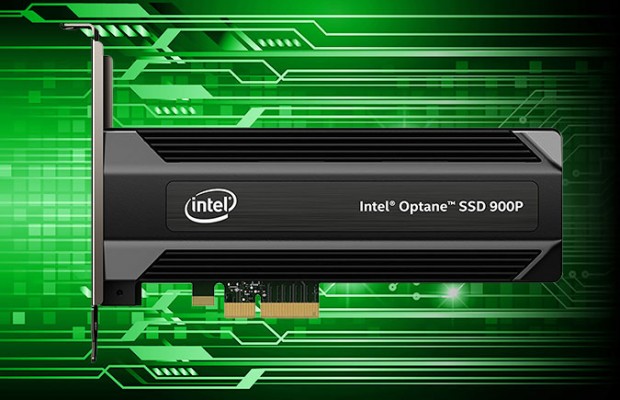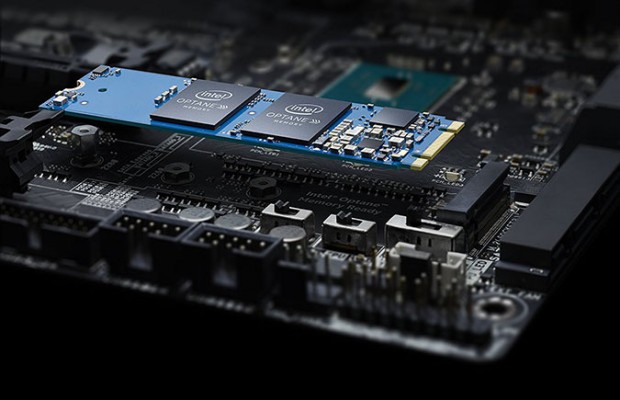What Is Intel Optane? The Memory That Gives Hard Drives SSD Speeds
Is your computer sluggish? It could be that your old spinning hard drive isn't cutting it anymore. As we've said before, the easiest way to improve the performance of a PC is to purchase a solid-state drive; however, SSDs are considerably more expensive than hard-disk drives in terms of dollar per gigabyte.
Fear not, Intel has a solution. First unveiled in 2017, Optane is a memory module designed to ramp up PC speeds for less money. It promises a better computing experience for every user, from gamers to power users. Sound too good to be true? Here's what you need to know about Intel Optane.
Quick Summary:
- Intel Optane is a new, superfast memory module.
- The main benefit of Optane is improved storage performance.
- Laptop makers sell notebooks with Optane memory, or you can buy it online.
- Intel Optane costs $34 and $54 for 16GB and 32GB, respectively.
What is Intel Optane?
At its core, Intel Optane is a technology system designed to greatly improve storage speeds by caching your computer's most frequently used processes for the hard drive. The technology uses 3D XPoint, a new type of memory that its creators, Micron and Intel, claim is 1,000 times faster than traditional NAND flash.
With its new memory type, Optane enables what Intel calls "system acceleration," or faster task completion and reduced wait times when compared to spinning hard drives without Optane. For everyday users, this means your favorite applications will load significantly faster than they did before.
Buy Intel Optane Memory Module 16 GB on Amazon.com
Sign up to receive The Snapshot, a free special dispatch from Laptop Mag, in your inbox.
It's important to note that Intel Optane is not a replacement for DRAM — rather, it works in conjunction with it. Using intelligent algorithms, Optane accesses and remembers long-term memory, or what remains on your computer after it's powered off. This results in decreased wait times when you load games, documents, pictures and apps. Despite how some OEMs misleadingly list Intel Optane, it does not act as primary system memory, like DRAM, which accesses short-term memory until your laptop is turned off.
Buy Intel Optane Memory Module 32 GB on Amazon.com
Intel Optane is used in two different ways. Since it launched last year, Optane has been available as 16GB and 32GB PCIe M.2 memory modules used to accelerate a conventional hard drive in the same manner as an SSD cache. Intel claims that a desktop or laptop equipped with a hard drive as primary storage and a secondary Optane cache could load Windows 10 faster than a laptop with an SSD.
MORE: Which Laptop CPU is Right for You?
The other form Optane takes on is in a series of Intel SSDs equipped with 3D XPoint memory. The latest product in the SSD lineup, the 905P, is lightning-fast and remarkably expensive.
How much faster will Optane make my PC?
Thanks to the superfast memory, laptops with Optane technology are much faster and more responsive than those without it. Specifically, Optane enables faster boot times, application load times and data load times, and can improve the PC experience for a variety of users, from those who simply browse the web to professional power users.
According to Intel, an 8th Gen Intel Core processor with Optane performs everyday tasks 2.2 times faster than a CPU without the memory tech. Additionally, large files are estimated to open three times faster than they would without Optane.
Buy Intel Optane SSD 900P Series on Amazon.com
Gamers on a budget should also consider a laptop equipped with an Optane cache. According to Intel, 8th Gen Intel Core processors armed with Optane memory allow for 4.7 times faster loading times than computers without it. Better yet, since Optane works with traditional hard drives, gamers can keep their large storage capacities without sacrificing SSD-type speeds.
MORE: Laptops with the Longest Battery Life
While that all sounds impressive, what is more relevant to consumers is how Optane performs in the real world. So far, the technology has impressed. Our sister site, Tom's Hardware, called the Intel Optane SSD 905P — a high-end drive for desktops and workstation — the "fastest SSD ever made." And, using the SYSmark benchmark, AnandTech determined that a 32GB Optane memory module improved the response time of a conventional HDD across the board and even outperformed SSDs on some tests. Unfortunately, those gains come at the expense of power consumption, so expect Optane-powered laptops to have worse battery life.
What system requirements are there for Optane?
If you're buying a new laptop with Optane, the technology will come preinstalled. Laptop makers — Dell, HP, Lenovo — already sell laptops outfitted with Optane cache drives alongside high-capacity HDDs. Specific laptops with configurations that include Optane memory include the Dell Inspiron 15 5000, the Lenovo Ideapad 330s and the HP 15-da0032. Note, however, that adding Optane to an old laptop is tricky, since OEMs need to push a BIOS update for Optane to work with their motherboard. It's possible, but even the most tech-savvy customers will find it difficult to add Optane into an existing laptop.
The Intel Optane component you can purchase separately lets you upgrade your desktop's hard-drive speeds. However, there is a set of minimum system requirements for getting the memory module working on your rig. You need a 7th Gen Intel Core CPU (Core i3, i5 or i7) or later, an Intel 200-series chipset or newer, and an M.2 2280 slot with two or four PCIe data lanes. Desktops and laptops equipped with Celeron, Pentium or older Core processors won't support Optane. Your rig must also run the 64-bit Windows 10 operating system and have Intel Rapid Storage Technology 15.5 or newer installed.
Intel Optane cost and availability
Buying a laptop or desktop with Optane memory will simplify things, but you can always add it to your device if it meets the aforementioned requirements.
One major benefit of Optane is that you don't need as much memory to see performance gains. This helps keep pricing relatively low. The 16GB M.2 memory, which Intel claims is best used for mainstream usage, costs $34 on Amazon at the time of writing. The larger 32GB model, which is better for gaming and professional use, goes for $54.
Designed for the most demanding workloads, Intel's Optane-based SSDs are extremely fast and exorbitantly priced. A 960GB version of the 905P model costs a resounding $1,300.
Credit: Intel; Shutterstock
Phillip Tracy is the assistant managing editor at Laptop Mag where he reviews laptops, phones and other gadgets while covering the latest industry news. After graduating with a journalism degree from the University of Texas at Austin, Phillip became a tech reporter at the Daily Dot. There, he wrote reviews for a range of gadgets and covered everything from social media trends to cybersecurity. Prior to that, he wrote for RCR Wireless News covering 5G and IoT. When he's not tinkering with devices, you can find Phillip playing video games, reading, traveling or watching soccer.





